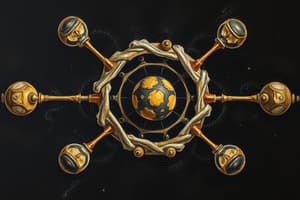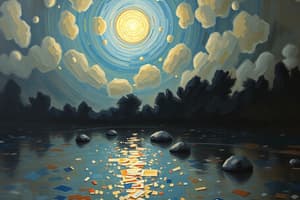Podcast
Questions and Answers
What is the relative mass of electrons compared to protons and neutrons?
What is the relative mass of electrons compared to protons and neutrons?
- The same
- 1/2000th (correct)
- One-half
- One-twentieth (correct)
What happens to an atom if it loses electrons?
What happens to an atom if it loses electrons?
- It becomes a negative ion
- It disappears
- It remains neutral
- It becomes a positive ion (correct)
What is the approximate radius of an atom?
What is the approximate radius of an atom?
- 100 nanometers
- 10 nanometers
- 0.1 nanometers (correct)
- 1 nanometer
What is the main function of the periodic table?
What is the main function of the periodic table?
What is the nucleus of an atom composed of?
What is the nucleus of an atom composed of?
What makes up most of the space in an atom?
What makes up most of the space in an atom?
Flashcards are hidden until you start studying
Study Notes
- Everything, including living and non-living things, is made up of tiny particles called atoms.
- A single cell likely contains more than 100 trillion atoms.
- An atom is made up of multiple smaller particles, with a central nucleus surrounded by electrons orbiting in rings called shells.
- The nucleus is made up of two types of particles: protons and neutrons, packed together in a tight ball.
- Protons and neutrons have the same mass, with a relative mass of one.
- Electrons have a mass 2,000 times smaller than protons and neutrons, often written as zero.
- Protons have a positive charge of one plus, neutrons have no charge and are neutral, and electrons have a negative charge of one minus.
- The size of an atom depends on the element it is, with an average radius of around 0.1 nanometers.
- Most of an atom is empty space, with the nucleus being very small compared to the outer electrons.
- The nucleus is 10,000 times smaller than the width of the atom itself.
- Electrons are even smaller and would be too small to see if drawn to scale.
- Atoms can lose or gain electrons, becoming charged and turning into ions.
- If an atom loses electrons, it becomes a positive ion, and if it gains electrons, it becomes a negative ion.
- The periodic table is a table that represents different types of atoms, called elements, with each box representing a different element.
- Each box in the periodic table is called a nucleus symbol and tells us information about the element.
- The elemental symbol represents the element, the atomic number tells us how many protons the atom has, and the mass number tells us the total number of neutrons and protons in the atom.
- The number of protons in an atom determines which element it is, and the atomic number also tells us how many electrons the atom has.
Studying That Suits You
Use AI to generate personalized quizzes and flashcards to suit your learning preferences.




